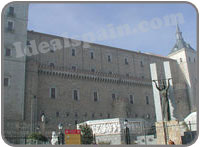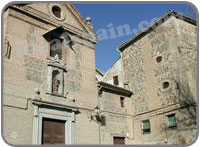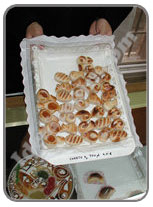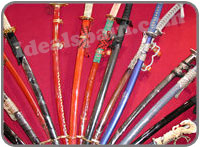|
What to see in Toledo
The city gates of Toledo
|
| You
will
enter
the
city
centre
by
means
of one
of the
huge
stone
gateways. Nothing remains of the Bab Tafalin Gate which was the Gate of the Clay Sellers. However, the Old Bisagra Gate remains pretty much as it was built. This gate was probably the main gate to the city at one time. The Bab al Mardum Gate is an Arab construction that has been re-modelled. The original horseshoe arch has been rebuilt in a semi-pointed style. The small Mosque can be seen on the inner side of the gate. This Mosque is quite unique as it is very small for a Mosque and does not conform to the conventional layout. The Puerta del Sol (Sun Gate) was built to accommodate wagons between 1375 and 1399. It is said to be the finest Mudejar style gate in the whole of Spain. Other gates include the Cambron Gate, which has been identified as the Gate of the Jews (Bab al Yahud). This gate was remodelled in the 16th century, with two towers being added, forming an inner courtyard. |
| |
| It is
impossible
to
walk
the
streets
without
coming
across
an
important
building
and we
couldn't
possibly
write
about
them
all on
this
one
page.
When
you
arrive
in the
city,
you
will
find
car
parking
a
problem.
Don't
even
think
about
taking
your
car
into
the
historic
centre.
You
should
make
your
way to
the
Cathedral
first,
right
in the
centre
for
this
is
where
you
will
find
the
tourist
office
who
will
give
you a
handful
of
information
and a
street
plan. |
|
|
| The Cathedral (right) is
described
as one
of the
most
extraordinary
in
Spain.
Construction
was
begun
in
1226
but it
took
300
years
to
build.
The
result
is a
mainly
Gothic
style
building
but
showing
a
multitude
of
influences.
Make
sure
that
you
walk
all
the
way
round
and
examine
all
four
sides
as
each
is
very different.
If you
have
time,
take a
tour
of the
museum
inside
where
you
will
see a
multitude
of
Spain's
most
precious
paintings
and
the
Cathedral
treasure. |
|
| |
|
Opposite
the
Cathedral
is the
Town
Hall
(right),
beneath
which
is the
tourist
office.
The
building
is of
Renaissance
style
with
two
towers
with
Baroque
spires.
Close
by is
the
Convent
of
Santa
Isabel
de los
Reyes,
dating
from
1477,
the
church
is
usually
open
all
year
round
and
contains
two
palaces. The Church of San Juan de los Reyes is another building worthy of a visit. The church stands in the Jewish quarter and has a stunning octagonal dome. It dates from 1476. |
 |
|
|
|
 |
Perched
on the
highest
point
of the
city
is the
Alcazar
(left) |
The Alcazar and its museums
It stands on the Cervantine Hill, the highest point of the city and was once a
fortress
that
was
the
imperial
residence
and
later
a
military
museum
and
library.
This
is the
location
where
all
the
forts
have
been
built
since
Roman
times.
On the
eastern
side
you
will
see
remains
of the
original
castle.
A
terrace
lookout
offers
wonderful
views
over
the
valley
and
the
river. Rumour has it that El Cid was once the governor here and he stationed his troops here. The building was converted into a Royal palace by Carlos V who employed the very finest architects and designers. When the Royal court eventually moved to Madrid, the palace was simply used for ocassional Royal visits. It suffered several severe fires over the years, the first being in 1710 during the wars of Succession. In 1810 Napoleon's troops set fire to the building and in 1936 it was besieged during the Spanish Civil War. The Alcazar now houses several museums:
Siege museum
Romero Ortiz collection of historic objects and medals
Santa Cruz Museum
|
San Servando Castle
At the time of the foundation of the castle by Alfonso VI, this castle served as a monastery for monks of the Clunic order. It was later used by the Templar Knights. The castle has suffered much damage over the years but was restored in 1949. It then became a college but is now a youth hostel. The castle (pic below right) stands on the opposite side of the river. |
| |
|
Museums in Toledo
Toledo is home to the
El
Greco
House
Museum,
an
elegant
building
dedicated
to the
life
of the
celebrated
painter.
One of
the
most
famous
names
of
Toledo
is El
Greco
whose
works
are
everywhere.
The
Casa
Museo
de El
Greco
is
located
in
C/Samuel
Levi,
Tel Nº
925 224 046.
The Museum of Modern Art is located in a specially converted Toledan house called the House of Chains. The museum houses a fine collection of works including paintings, bronzes and sketches.
The Museum of the Duchess of Lerma is located in the Hospital de Cardinal Tavera building. The museum has a perfectly preserved infirmary with some very rare exhibits. The Duchess took up residence in the hospital and brought with her, a superb collection of artwork which is now on display here. |
 |
|
|
|
 |
Getting around Toledo
Toledo
is an
easy
excursion
from
Madrid,
by
coach
or
train.
You
must
explore
the
city
by
foot
and
most
places
of
interest
are
within
easy
walking
distance.
Wear
suitable
footwear
as
most
of the
roads
are
cobbled
and
walking
can be
tedious.
The
city
offers
ample
accommodation
of all
grades
and
there is a
wide
selection
of
bars
and
restaurants.
The
city
can
become
very
crowded
in the
summer
and
can be
very
cold
in the
winter.
If you
do
take
your
car,
be
careful
where
you
park.
Street
parking
is
controlled
by
meters
and
traffic
wardens
are
keen. |
|
|
| Just
outside
the
city
walls
you
can
visit
the
remains
of a Roman
circus (right).
In the
garden
area
near
the
Hospital
de
Tavera
you
will
see
what
was
once
one of
the
largest
in the
Roman
Empire
and
closest
to the
Circus
Maximus
in
Rome
which
signifies
the
importance
of
Toledo
in
ancient
times. The circus had a capacity for 25,000 spectators and was 425 metres long. Many of the houses in this quarter are built over Roman foundations. |
|
| |
|
Shopping in Toledo
Toledo
has
its
own
specialities
on
offer
for
the
tourist
and
there
is a
massive
craft
movement
in the
city.
The
city
is
famous
for
the
production
of
marzipan,
often
moulded
into
little
sweets
of
various
shapes
and
sizes.
Pictured
below
is a
selection
in a
small
shop. |
|
|
|
 |
Other
local
crafts
include
top
quality
lace
ware
and
Toledo
jewellery.
Pictured
below
is a
selection
of
swords
for
which
Toledo
is
famous.
Shops
on
every
corner
have
hundreds
to
choose
from. |
|
|
|
Eating
out in Toledo
Toledo
is not
a
popular
place
for
vegetarians;
it is
indeed
serious
hunting
territory,
with
venison,
partridge
and
wild
boar
on
most
menus.
Toledo
does
however
have a
massive
selection
of
restaurants
to
choose
from,
ranging
from
basic
snacks
to
full,
expensive
meals. |
 |
|
|
|
 |
|
|
|
 |
Local Police, Toledo - Tel 925 250 412
Civil Protection, Toledo - Tel 925 269 720
Fire Brigade, Toledo - Tel 925 226 080
City Council, Toledo - Tel 925 269 702
Municipal Archives, Toledo - Tel 925 269 748
Centre of Information, Toledo - Tel 925 269 733
House of Culture, Toledo - Tel 925 265 410
Buenavista Library, Toledo - Tel 925 251 286
Santa Barbara Library, Toledo - Tel 925 214 756
Sta. Mª Benquerencia Library, Toledo - Tel 925 231 295
Cemetery, Toledo - Tel 925 220 395
Tourist Information Toledo
Plaza del Consistorio, 1 - 45001 Toledo
T. +34 925 254 030 - Fax: +34 925 255 946
www.toledo-turismo.com : : info@toledo-turismo.com
Justice Courts in Toledo
Bajada del Calvario s/n
Tel: 925 259 800
Offcial website here
|
|
 |
Bus Station Toledo
Avda de Castilla-La-Mancha
Toledo
Tel: 925 215 850
See bus stops in Toledo here |
Taxis in Toledo
Tel:
925 255 050 or
925 227 070
Official price list here |
| |
|
|
| |
|
|
| |
|
|
| |
|
| |
|
|
 |
Theatre de Rojas, Toledo
Plaza Mayor s/n
Tel 925 215 708
www.teatroderojas.es |
|
| |
|
|
| |
|
|
| |
|
|
| |
|
|
| |
|
|
|
| |

